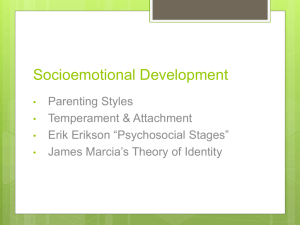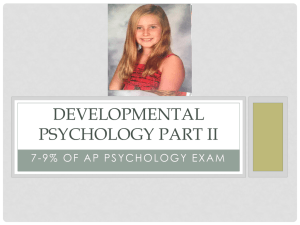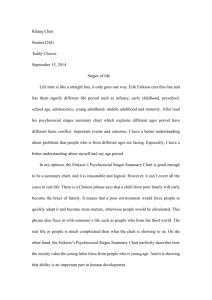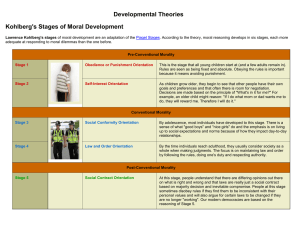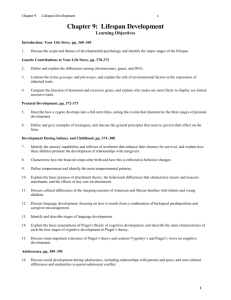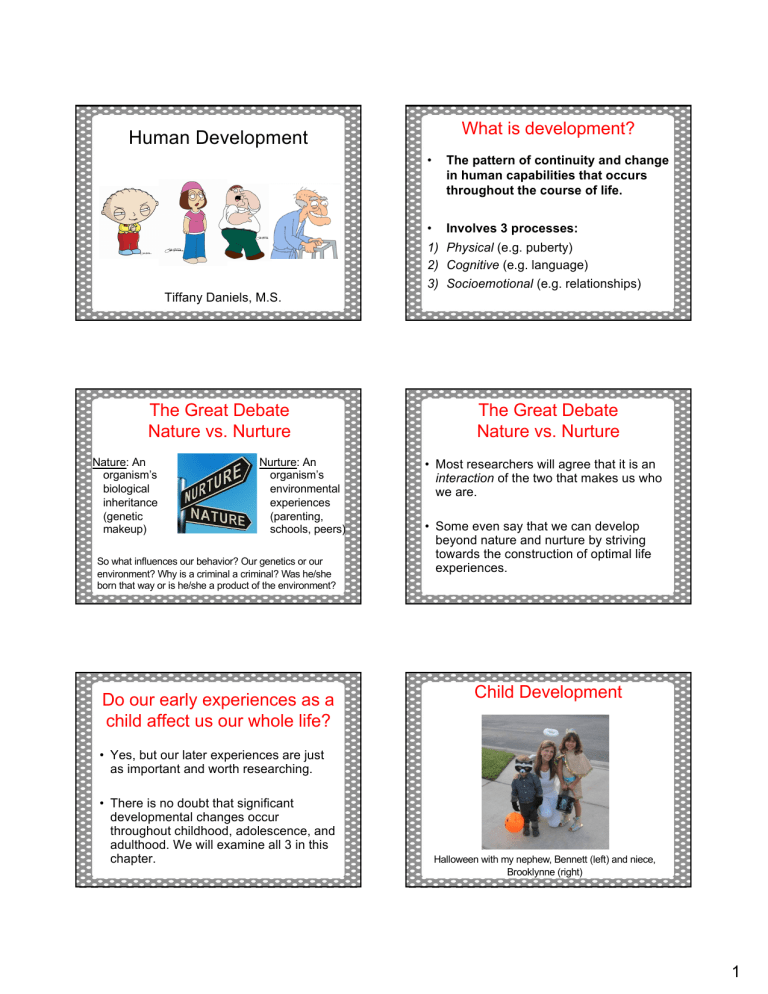
What is development? Human Development Tiffany Daniels, M.S. The Great Debate Nature vs. Nurture Nature: An organism’s biological inheritance (genetic makeup) Nurture: An organism’s environmental experiences (parenting, schools, peers) So what influences our behavior? Our genetics or our environment? Why is a criminal a criminal? Was he/she born that way or is he/she a product of the environment? Do our early experiences as a child affect us our whole life? • The pattern of continuity and change in human capabilities that occurs throughout the course of life. • Involves 3 processes: 1) Physical (e.g. puberty) 2) Cognitive (e.g. language) 3) Socioemotional (e.g. relationships) The Great Debate Nature vs. Nurture • Most researchers will agree that it is an interaction of the two that makes us who we are. • Some even say that we can develop beyond nature and nurture by striving towards the construction of optimal life experiences. Child Development • Yes, but our later experiences are just as important and worth researching. • There is no doubt that significant developmental changes occur throughout childhood, adolescence, and adulthood. We will examine all 3 in this chapter. Halloween with my nephew, Bennett (left) and niece, Brooklynne (right) 1 Prenatal Development Threats to the Fetus • Teratogen: any agent that causes a birth defect (alcohol, cigarettes, drugs) • Fetal alcohol syndrome (FAS) - cluster of abnormalities that occurs in children born to mothers who are heavy drinkers. May include: small head, wide-spaced eyes, flat nose, lower intelligence. How do psychologists study infants when they can’t talk? • Preferential looking - A test of perception that gives an infant a choice of what to look at. If the infant shows a reliable preference for one stimulus over another when they are repeatedly presented, we can infer that the infant can distinguish between the two. How do psychologists study infants when they can’t talk? • Preferential looking and habituation studies have found that as early as 7 days old, infants are already perceiving and organizing faces. • At 3 months, they prefer real faces to scrambled, and their mother’s face to a stranger’s. Full-term vs. Pre-term infants • Studies show that pre-term infants (born prior to 38 weeks after conception) are more likely to have developmental problems such as learning disorders, especially if they grow up in poverty. • A study conducted by Field (1986) showed that massaging infants for 15 minutes 3 times a day can help with weight gain and performance on developmental tests. How do psychologists study infants when they can’t talk? • Habituation: decreased responsiveness to a stimulus after repeated presentations • Ex: A patterned square is presented repeatedly to the infant until it is no longer interesting. Then, a slightly different patterned square is presented. If there is no change in interest, then we can assume the infant did not notice it. Cognitive Development in Childhood - Jean Piaget • Cognitive development how thought, intelligence, & language processes change as people mature. • Piaget posited that children actively construct their cognitive world in stages. 1896-1980 2 Piaget’s Theory of Cognitive Development • Children use schemas to make sense of what they experience. A schema is a concept or mental framework that exists at any given moment in a person’s mind that helps him or her organize information. • They may have a schema for sucking, licking, crawling, etc. Piaget’s Theory of Cognitive Development Piaget’s Theory of Cognitive Development • We use and adapt schemas in 2 ways: • Assimilation: An individual’s incorporation of new information into existing knowledge • Accommodation: An individual’s adjustment of a schema to new information Piaget’s 4 Stages of Cognitive Development • Example: A child may learn that objects can be picked up. This is assimilation, the addition of new knowledge to an existing repertoire. Realizing that only some objects can be picked up (a toy) and others cannot (the couch) is accommodation. The child is making adjustments/modifications to the existing knowledge. Sensorimotor Stage (birth - 2 years) • Infants coordinate sensory experiences (ex: seeing, hearing) with motor experiences (ex: arm movements) • The goal in this stage is to obtain object permanence - understanding that objects exist even when they cannot directly be seen, heard, or touched. • Ex: Peekaboo - If they have not developed object permanence, they really think you’re gone! Preoperational Stage (ages 2 - 7) • Begin to represent the world with words, images, art. • Have difficulty reversing operations. For example, they can add, but subtraction is difficult. Their thought is intuitive, oftentimes involving guesswork instead of logic. • Have not yet grasped the concept of conservation, a belief in the permanence of certain attributes of objects or situations despite superficial changes. 3 Preoperational Stage (ages 2 - 7) Preoperational Stage (ages 2 - 7) • Children at this stage are also egocentric, meaning they cannot distinguish between their own perspective and the perspective of someone else. In the second picture, which has more, A or C? A child in the preoperational stage would say C. Above: Piaget’s Three Mountain Task Concrete Operational Stage (ages 7 - 11) • Children in this stage can start to use operations, classification, and logic instead of intuition and guesswork. They are able to solve conservation problems. • However, they think “concretely” and are not yet thinking abstractly. They struggle using logic in situations that are illogical. Formal Operational Stage (11-15 yrs through adulthood) • Involves abstract, idealistic, logical thought. • Individuals in this stage can generate hypothetical possibilities and use systematic reasoning to solve problems. • Not everybody makes it to this stage. 4 Evaluating Piaget’s theory http://www.youtube.com/watch?v=TRF27F2bn-A • Pros: Introduced testable concepts that have endured across time. Envisioned children as active thinkers who construct their own world. • Cons: Some kids go through the stages earlier or later than hypothesized. Doesn’t account for individual, educational & cultural differences Some view development as a continuous process, not chopped up into stages. Erikson’s 8 Stages of Socioemotional Development • • • • • • • • Stage 1: Trust vs. Mistrust Stage 2: Autonomy vs. Shame & Doubt Stage 3: Initiative vs. Guilt Stage 4: Industry vs. Inferiority Stage 5: Identity vs. Identity Confusion Stage 6: Intimacy vs. Isolation Stage 7: Generativity vs. Stagnation Stage 8: Integrity vs. Despair Erikson’s 8 Stages of Socioemotional Development • Stage 2: Autonomy vs. Shame & Doubt • Ages 1.5 - 3 • Children realize that they have a will of their own and begin to develop a sense of autonomy, but if they are restrained too much or punished too harshly, they may develop a sense of shame/doubt. Erikson’s theory of Socioemotional Development • 8 Stages from infancy through old age • Each stage has a crisis that one must negotiate. Erik Erikson (1902-1994) • The more successful the negotiation, the more competent the individual becomes. Erikson’s 8 Stages of Socioemotional Development • Stage 1: Trust vs. Mistrust • Birth through age 1.5 • Trust is built if basic needs (food, shelter, etc.) are met by a sensitive caregiver. Mistrust develops if needs are not met. Erikson’s 8 Stages of Socioemotional Development • Stage 3: Initiative vs. Guilt • Ages 3 - 5 • When asked to assume more responsibility for their actions, children can develop initiative. When permitted to be irresponsible, or if they feel anxious about the responsibility, they can develop guilt. 5 Erikson’s 8 Stages of Socioemotional Development • Stage 4: Industry vs. Inferiority • Ages 6 until puberty • Children achieve industry (feeling worthwhile) by mastering knowledge and intellectual skills. If they don’t, they can feel inferior, unproductive, or incompetent. Identity Status Erikson’s 8 Stages of Socioemotional Development • Stage 5: Identity vs. Identity Confusion (ages 10 through 21) In seeking an identity, adolescents are trying to figure out who they are, how they fit in, & where they are headed in life. If they do not adequately explore their identity, they can become confused. They might become withdrawn or get completely lost in the crowd. Identity Status • James Marcia (1980) expanded upon Erikson’s notion of identity confusion and named 4 identity statuses to describe a person’s position in his or her identity development. • Identity diffusion - Person has neither explored identity options nor made a commitment (ex: most young adolescents) • Identity development involves 2 processes: the exploration of various options and the commitment to options. • Identity foreclosure - Person makes a commitment to an identity before exploring other options. (ex: becoming a doctor because that’s what your parents want you to be) Identity Status • Identity moratorium - Person is exploring options, but hasn’t made a commitment (ex: the typical college freshman) • Identity achievement - Person has explored alternative paths and has made a commitment (ex: the typical college graduate) Erikson’s 8 Stages of Socioemotional Development • Stage 6: Intimacy vs. Isolation – Emerging Adulthood (ages 18-25) The task here is to form intimate relationships with others. If not, we become socially isolated. This involves both finding oneself and losing oneself in another. Awwwww….. 6 Erikson’s 8 Stages of Socioemotional Development • Stage 7: Generativity vs. Stagnation (ages 25-65) Main concern here is to help the younger generation (especially one’s children) in developing useful lives. This is called generativity. The feeling of having done nothing is stagnation. Evaluating Erikson’s Theory • Pros: Focus away from sexuality (as Freud had done) Stresses the importance of overcoming socioemotional tasks • Cons: Research based on mostly case studies There are other tasks going on in each stage besides the 2 he describes Erikson’s 8 Stages of Socioemotional Development • Stage 8: Integrity vs. Despair (age 65 – death) Integrity involves looking back on one’s life and feeling proud, satisfied. Despair is the doubt, gloom, and disappointment than an individual may have regarding how his or her life was spent. Other Developmental Topics of Study • Attachment (especially in infancy) • Temperament • Parenting Styles • Moral Development • Marriage • Cognitive Development in Adulthood • The Mid-Life Crisis • Life Span and Life Expectancy • Alzheimer’s Disease Attachment in Infancy •Attachment - the close emotional bond between an infant and its caregiver. •Attachment is instinctive and intensifies by the time the infant is 6-7 months old. • Classic attachment study was conducted by Harry Harlow (1958) 7 Attachment in Infancy • In Harlow’s study, monkeys were fed by either a cold wire mother or a warm cloth mother. • Regardless of which mother was feeding them, they spent way more time with the cloth mother than the wire mother, demonstrating that warmth and intimate contact was more important than food. • The most time was spent with the cloth mother who also provided food. Attachment in Infancy • The securely attached child: • Is upset when the mother leaves but calms down quickly • Is happy when the mother returns • Moves freely from the mother when she’s around but keeps periodic “tabs” • The insecurely attached child: • During interactions, avoids the mother completely or is ambivalent towards her • May not even notice the mother is gone, or quite the opposite, may never get over her absence • Fears strangers and is upset easily by minor situations The 4 Parenting Styles • Authoritarian: restrictive, punitive style in which the parent exhorts the child to follow the parent’s directions and to value hard work and effort. Ex: The military dad • Authoritative: style that encourages children’s independence (but still places limits and boundaries), verbal give and take, and warm, nurturing interactions. Ex: The Bradys Attachment in Infancy • Mary Ainsworth (1978) devised the strange situation to see how children responded when their mother left the room and then subsequently returned. This helped her identify children who were securely vs. insecurely attached to their mothers. Temperament • Temperament - An individual’s behavioral style and characteristic way of responding. • Three types of temperament in children: the easy child, the difficult child, and the slow-towarm up child. • Some determinants of temperament may include the ability to regulate emotions, shyness, and negative affectivity (frustration or sadness). Temperament can influence parenting styles. The 4 Parenting Styles • Neglectful: style in which the parents are uninvolved in their children’s life. Ex: movies stars who are too busy with their careers to spend time with their kids • Indulgent/Permissive: permissive style in which parents are involved but place few limits on them. Ex: The “cool” mom 8 The 4 Parenting Styles • Not surprising, the most effective parenting style is authoritative. Children of authoritative parents tend to be socially competent, responsible, independent. • Children of the other 3 styles tend to have anxiety about social comparison, lack of initiative, and poor communication • A wife is near death from a rare cancer. There is one drug that might save her. The only druggist who makes the drug sells it for $2000 even though it only costs him $200 to make. After doing everything he can to raise the money, the wife’s husband can only afford to pay $1000. The druggist will not sell the drug unless he receives the full amount. Desperate, the husband breaks in to the drug store and steals the drug for his wife. What do you think? Are his actions right or wrong? Why? Moral Development • Conventional Level - Based primarily on standards such as those learned from parents (stage 3) or society’s laws (stage 4) “He should steal the drug because that’s what a good husband should do.” “He can’t steal because it’s against the law.” Moral Development • Lawrence Kohlberg’s Theory • Moral development includes people’s basic values but also includes what they should to in interactions with others. • 3 levels, 6 stages Lawrence Kohlberg (1927-1987 Moral Development • Preconventional Level - Based primarily on punishments (stage 1) or rewards (stage 2) that come from the external world. “The husband cannot steal the drug because he might get caught.” “He should steal the drug because his wife will owe him a favor.” Moral Development • Postconventional Level - Based on a personal moral code reflecting the principles generally accepted by the community (stage 5) or more abstract principles for humanity (stage 6) “The law was not set up for these circumstances, so he should steal it.” “The wife’s life is more important than this law, so he should steal the drug.” 9 Evaluating Kohlberg • Examined how people think about moral issues however… • Moral reasoning does not necessarily mean moral behavior. • Focus is on the individual’s decision without accounting for the influence of interpersonal relationships. Marriage • People are getting married later in life nowadays than they did in the past. In the year 2018, the median age for first marriages was nearly 28 for women and almost 30 for men. What is a median again? • Studies show that the older an individual is when he or she marries, the lower the chance of divorce. • Average length of a marriage: ~9 years Marriage • A successful marriage demonstrates 4 principles: 1) Fondness & Admiration 2) Friendship & Emotional Support 3) Shared Power 4) Positive Conflict Resolution Cognitive Development in Late Adulthood Cognitive Development in Middle Adulthood • Crystallized Intelligence - an individual’s accumulated information and verbal skills (ex: vocabulary) • Fluid Intelligence - an individual’s ability to reason abstractly. (ex: puzzle solving ability) • Crystallized intelligence tends to improve in middle adulthood, yet fluid intelligence tends to decline. “Use it or lose it.” The Midlife Crisis • Some cognitive abilities sharply decline with age (perceptual speed, memory), however, other areas seem to improve with age. One area is wisdom, the expert knowledge about the practical aspects of life. • “When I was your age….” • Contrary to what you see in the media, only 10% of the general population experiences a midlife crisis. https://www.youtub e.com/watch?v=gx kNuHrS6cg 10 Life Span/Life Expectancy • Life span - the upper boundary of a species life. Ours is 120. • Life expectancy - # of years that will probably be lived by the average person. Ours has extended as a result of industrialization & advancements in medicine. • U.S. Life expectancy as of 2017: ~80 years (ranked 42rd in the world) • Men = ~76.9 years Women = ~81.6 years Alzheimer’s Disease • An unfortunate condition that affects some individuals as they age. • Progressive, irreversible brain disorder that is characterized by gradual deterioration of memory, language, reasoning, and eventually, physical functioning. • Increasing number of tangles (bundles of proteins that impair neurons - the cells in our brain) and plaques (deposits that accumulate in the brain’s blood vessels) Alzheimer’s Disease Alzheimer’s Disease • The main treatment for Alzheimer’s Disease is Aricept, however more research is needed to examine its effectiveness in preventing the deteriorization in the brain. • http://www.youtube.com/watch?v=z1mcAAgr Cnw 11


